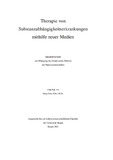Zitierlink:
http://dx.doi.org/10.25819/ubsi/10107Dateien zu dieser Ressource:
| Datei | Beschreibung | Größe | Format | |
|---|---|---|---|---|
| Dissertation_Tanja_Eiler.pdf | 15.03 MB | Adobe PDF |  Öffnen/Anzeigen |
| Dokumentart: | Doctoral Thesis | Titel: | Therapie von Substanzabhängigkeitserkrankungen mithilfe neuer Medien | Sonstiger Titel: | Therapy of substance dependence disorders with the help of new media | AutorInn(en): | Eiler, Tanja Joan |
Institut: | Fakultät V - Lebenswissenschaftliche Fakultät | Schlagwörter: | Cognitive Bias Modification, Approach-Avoidance Task, Mobile Anwendung | DDC-Sachgruppe: | 610 Medizin, Gesundheit | GHBS-Notation: | VYH HVRI |
Erscheinungsjahr: | 2022 | Publikationsjahr: | 2022 | Auch erschienen: | München: Verlag Dr. Hut, 2022. - ISBN 978-3-8439-5027-5 | Zusammenfassung: | Die Abhängigkeit von schädlichen Substanzen ist noch immer ein großes Problem unserer Gesellschaft und kostet jedes Jahr nicht nur den Sozialstaat viel Geld, sondern auch unzählige Leben. Trotz der Möglichkeit, eine Goldstandard-Therapie durchzuführen, wird dieses Angebot kaum wahrgenommen bzw. ist die Wahrscheinlichkeit eines Rückfalls enorm hoch. Die Cognitive Bias Modification (CBM) stellt eine vielversprechende neue Therapiemethode dar, welche darauf abzielt, Verzerrungen in kognitiven Informationsverarbeitungsprozessen direkt zu modifizieren. Eine große Schwachstelle der CBM, insbesondere bei der Modifizierung schädlicher Annäherungsverzerrungen mithilfe des Approach-Avoidance Task (AAT), sind die häufig wiederholten, monotonen Handlungen. Aufgrund dieser Probleme wurde eine Übertragung des AAT-Trainings in die virtuelle Realität (VR) angestrebt. Eine begleitende mobile Anwendung soll es den Betroffenen zudem erlauben, das AAT-Training auch außerhalb der orts- und zeitgebundenen VR-Laborsitzungen durchzuführen. Um diesen Forschungslücken zu begegnen, wurde zunächst eine umfangreiche Analyse des aktuellen Forschungsstands in diesem Bereich vorgenommen. Daran anschließend wurden jeweils zwei VR- sowie App-Demonstratoren entwickelt, welche eine Innovation im Feld der Therapie von Substanzabhängigkeitserkrankungen mithilfe neuer Medien darstellen. Dies liegt vor allem an der Verwendung von hochrealistischen Reizen und immersiven virtuellen Umgebungen (VE), welche das VR-Training unterhaltsam machen und dessen ökologische Validität steigern. Auch der Einsatz des Leap Motion Controllers verbessert die Übertragung in den Alltag, da dieser die Hand- und Armbewegungen der Probanden originalgetreu in die VE übertragt. Die exakte Zeitmessung erlaubt Bias-Messungen im VR-Kontext und erhöht damit die Validität der Messungen. Zur Beantwortung der Forschungsfragen wurden nach der Anwendungsentwicklung diverse Machbarkeitsstudien mit den VR-Demonstratoren sowie den App-Demonstratoren durchgeführt. Darüber hinaus wurde der finale VR-Demonstrator in Form einer randomisierten, kontrollierten Studie (RCT) erfolgreich evaluiert. Die Ergebnisse wiesen zwar nicht auf eine Modifikation der kognitiven Verzerrungen hin, jedoch konnte der Zigarettenkonsum signifikant reduziert werden. Zusätzlich kam es zu einer erfolgreichen Förderung eines positiven Gesundheitsverhaltens. Addiction of harmful substances is still a major problem in our society and does not only lead to extreme monetary costs for our society, but also to costs of life and health of human beings. Despite the possibility of gold standard therapies, this offer is hardly used, and the probability of relapse is enormously high. Cognitive Bias Modification (CBM) represents a promising new therapeutic modality that aims to directly modify cognitive biases. A major weakness of CBM, particularly in modifying harmful approach biases using the Approach-Avoidance Task (AAT), are the frequently repeated, monotonous actions. Due to these problems, a transfer of the AAT training to virtual reality (VR) was pursued. An accompanying mobile application is intended to allow those undergoing the AAT training to do so outside of the VR lab sessions, which are bound by location and time. To address these research gaps, a comprehensive analysis of the current state of research in this area was first conducted. Subsequently, two VR and two mobile application demonstrators were developed, each of which represent an innovation in the field of therapy of substance dependence disorders with the help of new media. This is primarily due to the use of highly realistic stimuli and immersive virtual environments (VE), which make the VR training entertaining and increase its ecological validity. Using the Leap Motion Controller also improves the transfer to everyday life, as it accurately transfers the hand and arm movements of the participants into the VE. The exact timing allows bias measurements in the VR context and thus increases the validity of the measurements. To answer the research questions, after the application development, various feasibility studies were conducted with the VR demonstrators as well as the app demonstrators. In addition, the final VR demonstrator was successfully evaluated in the form of a randomized controlled trial (RCT). Although the results show no modification of the cognitive biases, cigarette consumption was significantly reduced. Additionally, there was successful promotion of positive health behaviors. |
DOI: | http://dx.doi.org/10.25819/ubsi/10107 | URN: | urn:nbn:de:hbz:467-21962 | URI: | https://dspace.ub.uni-siegen.de/handle/ubsi/2196 |
| Enthalten in den Sammlungen: | Hochschulschriften |
Diese Ressource ist urheberrechtlich geschützt. |
Seitenansichten
411
checked on 03.04.2025
Download(s)
772
checked on 03.04.2025
Google ScholarTM
Prüfe
Prüfe
Alle Ressourcen in diesem Repository sind urheberrechtlich geschützt, soweit nicht anderweitig angezeigt.

